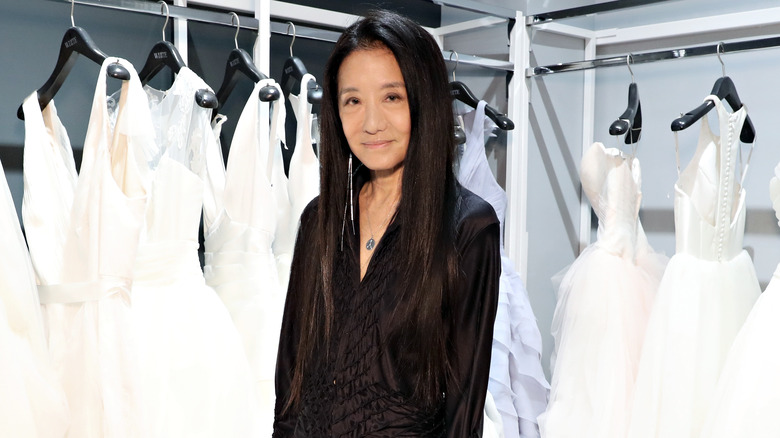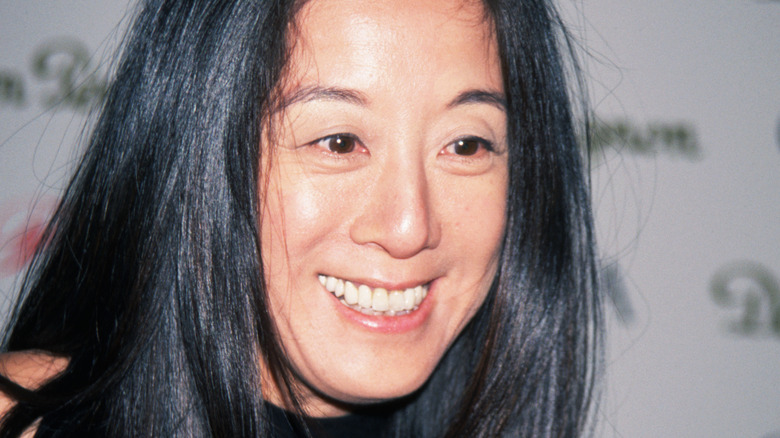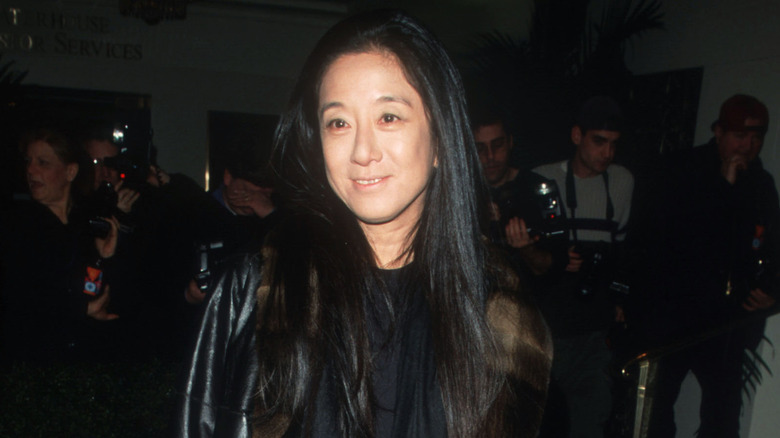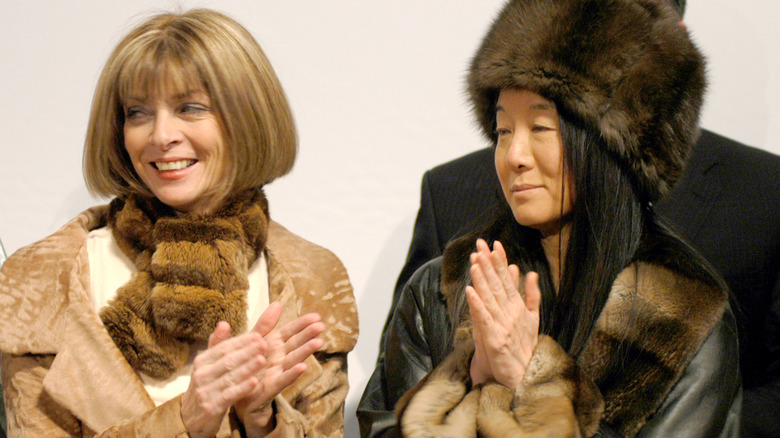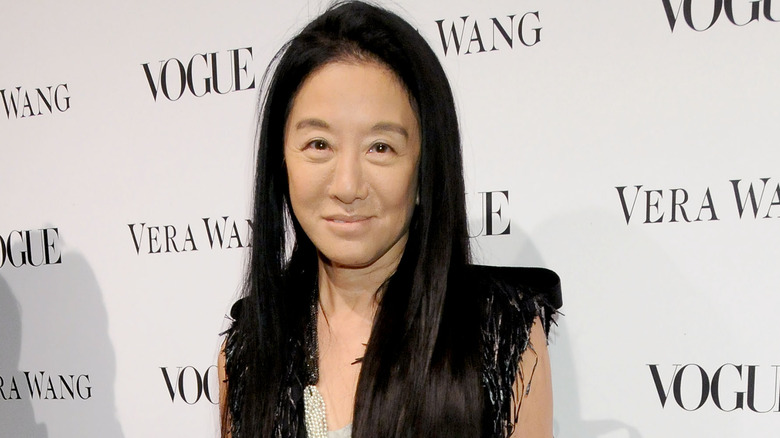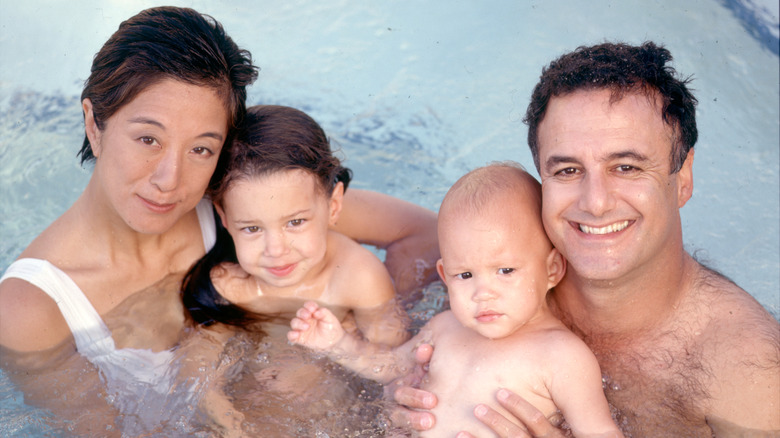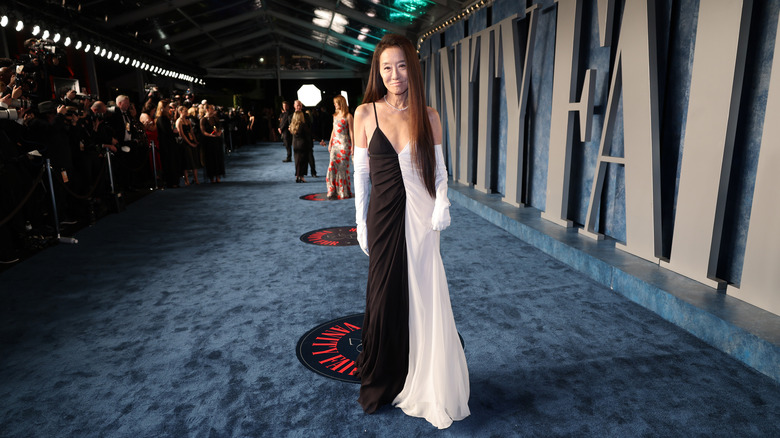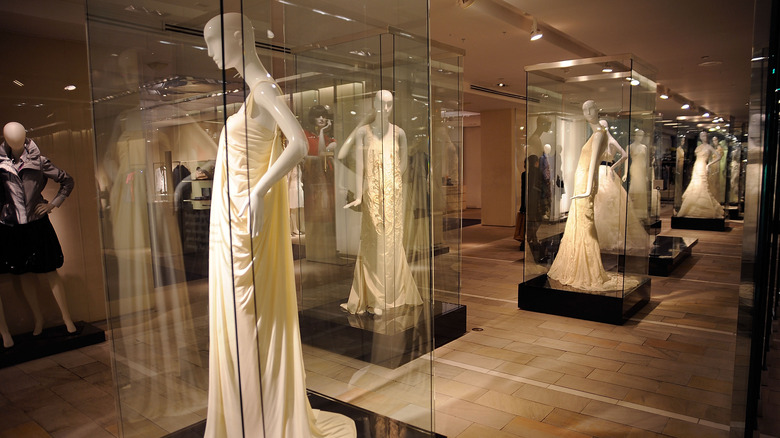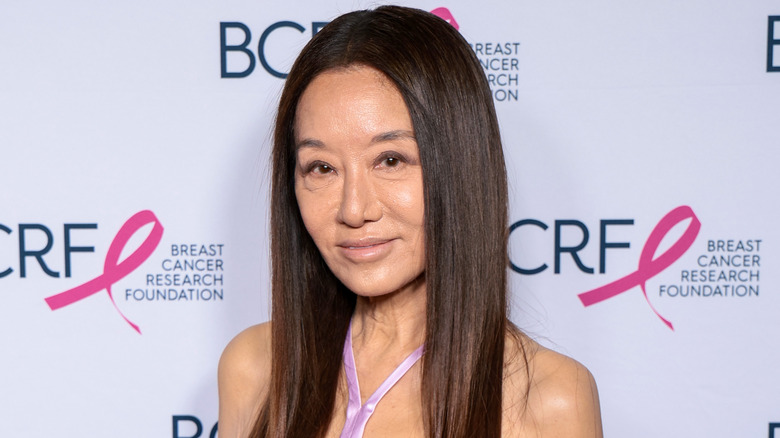Vera Wang's Journey To Being The Biggest Name In Wedding Dress Design
Vera Wang is a household name in the fashion industry, known for designing unparalleled wedding gowns and directing the business operations at her very own namesake label. Since the first opening of Wang's Manhattan boutique in 1990, dozens of celebrities have been wed in her dresses, including Ariana Grande, Gwen Stefani, and even '90s brides Posh Spice (Victoria Beckham) and Mariah Carey donned her gowns.
Instead of shying away from the nearly impossible task of creating the perfect wedding dress, Wang dove into the fastidious trade of bridal dressmaking and elevated it with both a sophisticated eye for haute couture and plenty of patience for a notoriously picky customer base. Thus, her success is no coincidence. While Wang has been building her fashion empire for some 30-plus years, her journey started long before the '90s.
Wang's career path has been long and winding, consisting of hard work, some failures, many achievements, and a little help from her parents. Dressed in her iconic all-black uniform, the fashion guru worked her way to becoming the biggest name in wedding fashion.
Vera Wang spent her early years in New York City's Upper East Side
Vera Wang hails from the fashion capital of the United States, New York City, where she was born in 1949 to affluent Chinese immigrants. Her parents fled the war in China in 1944, and upon arriving in the U.S., settled in New York, Wang told The New York Times.
Growing up in the Upper East Side neighborhood of Manhattan, her father owned a pharmaceutical company, and her mother was a United Nations translator. Wang attended the Chapin School, an all-girls private day school that has produced hundreds of notable alumni, including actor Sigourney Weaver and fashion designer Lilly Pulitzer. When she wasn't studying at one of the nation's most prestigious preparatory schools, Wang was taking classes at another elite institution — the American School of Ballet. At 19, she was the first Chinese woman to be presented at the International Debutante Ball in 1968.
The New Yorker stayed near her roots, choosing to attend Sarah Lawrence College. Although her father wanted her to study at Harvard like her siblings, Wang studied drama and art history — and even spent a term studying abroad at the Sorbonne in Paris. The experience piqued her interest in fashion, leading her to eventually pursue a career in the cutthroat industry.
She almost went to the Olympics
Long before her career as an influential designer, Vera Wang pursued a different career just as competitive as one in fashion. She began figure skating at just 8 years old, with a dream to make it all the way to the Olympics. Wang's unwavering determination and dedication can be seen in her former athletic career, when she would commute from New York to New Jersey almost every single night to practice on a public rink.
She was one of the top pairs skaters in the nation and even made it to the U.S. Figure Skating Nationals twice, but unfortunately, it wasn't enough for the Olympics. Wang and her partner, James Stuart, placed fifth at the 1968 U.S. Nationals, missing the qualifier by just two spots. She was heartbroken by the loss and decided to give up her career for good.
Although she no longer skates competitively, Wang is the designer of several iconic skating costumes. She debuted her work at the 1992 and 1994 Winter Olympics, dressing U.S. Nationals champion and Olympic silver medalist Nancy Kerrigan in high-necked pieces with stretch illusion sleeves that sparked a years-long fad. Wang also created costumes for Michelle Kwan in 1998 and 2002, Evan Lysacek in 2010, and gold medalist Nathan Chen in 2022. Wang's contributions to the sport earned her a spot in the U.S. Figure Skating Hall of Fame in 2009.
Academics were not her strong suit
Vera Wang has aspired to achieve great things since her childhood. As a second-generation Chinese American, her parents instilled in her the value of diligence, and anyone who takes one look at her long list of accomplishments can see it's true.
As a high school student, she was balancing her studies at one of America's top prep schools and her all-consuming Olympic training schedule at the same time. With those two major things vying for her attention, her talent for figure skating easily won out — Wang was unable to finish her classes at Chapin. She transferred to the Professional Children's School for her senior year and received her diploma there.
Just a couple of years after matriculating at Sarah Lawrence College, Wang again ran into some troubles with her studies. The college asked her to take an indefinite leave of absence, as her intensive preparation for the Games didn't allow her to focus much on her classes. But after her brutal loss in the 1968 U.S. Figure Skating Nationals and a subsequent nervous breakdown, Wang decided to give college another try. She enrolled in Sarah Lawrence's international program in Paris to start off her junior year, and the immersion into French culture introduced her to something that she loved just as much as figure skating – fashion. Wang set her sights on design school after graduation, but her father refused to pay for it. So instead, she sought a full-time job.
She became one of the youngest-ever editors at Vogue
Vera Wang's time abroad in the fashion capital turned out to be a pivotal move for her career. During her term at the Sorbonne in Paris, she fell in love with fashion, alternating between cheering on her boyfriend, who was the French national figure skating champion, and shopping at the crème de la crème of fashion boutiques like Kenzo (owned by Louis Vuitton). It was also then that Wang stumbled upon a Paris Vogue editor and immediately knew that she wanted to work at the magazine in the future.
What Wang didn't know at the time is that she would be on the Vogue team much sooner than she expected. When she returned to New York, she landed a summer job at Yves Saint Laurent's Madison Avenue boutique. Wang met the then-fashion director of Vogue, Frances Stein — also the designer of Halston's very first collection — when she came into the shop that summer. Stein was so impressed that she offered Wang a job at the magazine after college.
Upon graduating in 1971, Wang joined Vogue as an assistant and rapidly rose through the ranks to become the youngest fashion editor at Vogue by the age of 23. She worked with Anna Wintour, whose current job she almost secured in 1987.
Wang was different from many of her peers in the industry
Vera Wang has always marched to her own beat. Way before she was setting trends in bridal couture, she was shaking things up at her first full-time job. As Polly Allen Mellen, former fashion editor of Vogue and a style provocateur herself, told Harper's Bazaar, Wang walked into her first day of work donning a Yves Saint Laurent dress and sky-high pumps, despite the fact that she would be doused in sweat and elbow grease after a long day in the fashion closet. The editor politely sent Wang home to change, but she definitely made a strong first impression.
Aside from clothing choices, her personality was also unlike her fellow colleagues at Vogue. The industry has a reputation for being cruel (think "The Devil Wears Prada"), but Wang was a fast friend to all, designer Michael Kors told Harper's Bazaar. Wang was known for being funny and outgoing, and she enjoyed connecting with others — a contrast to some of her more serious, rigid peers. She brought the party to everyone around her, often hosting lively events in her own home.
She spent a couple of years as a designer for Ralph Lauren before growing her family
Sixteen years after landing her dream job at Vogue, Vera Wang decided to delve into the world of design. She pivoted from one major fashion hub to another – Ralph Lauren. The New York designer hired Wang to be his accessories design director in 1987. Ralph Lauren's empire was a similar precursor to her own — an American-born fashion mogul and businessman who built an entire brand from a single line of products (in his case, men's ties). During her two years at the company, Wang was in charge of designing 18 different lines of accessories, the designer told Harvard Business Review.
At the time, Wang was struggling with infertility issues, frequently getting shots, blood tests, and sonograms. The huge time commitment proved to be incompatible with her job, and she ended up quitting her directorship after just a couple of years in the role — the beginning of a decades-long fashion empire. Although the two designers split ways, Wang always had an immense level of respect for Lauren and learned so much in a short amount of time. Although her attempts to become pregnant were not successful in the end, she and her husband went on to adopt two daughters.
Vera Wang launched her bridal boutique just as she was getting married herself
By 1989, Vera Wang was engaged and planning her wedding to Arthur P. Becker, an investor and real estate developer. She soon realized that finding the perfect wedding dress is much more difficult than it looks, especially for a fashion-minded individual. Wang believed that she could not only introduce better options into the market but also reinvent it entirely. The combination of her decision to leave Ralph Lauren and her newfound need in the bridal industry created the perfect opportunity for her to do what she wanted all along — build something of her own.
Wang's father, Cheng Ching Wang, financed her dream in 1990. With a reported $4 million fund, she opened her very first boutique on Madison Avenue — a subtle nod to her first gig on the same street 20 years before — called Vera Wang Bridal House Ltd.
Wang offered something that no one else in the industry had before — sophistication and common sense that just couldn't be outdone. Her luxury shop was an instant hit, drawing in more customers than she could even dress, forcing her to turn away a multitude at the start.
She grew her brand into an empire
Vera Wang's growing success spurred on the massive expansion that we now call her fashion empire. Due to the high volume of celebrity brides rotating through her doors, Wang was on the front of every A-lister's mind when it came to fashion. She soon branched into evening wear, dressing a number of stars, including Holly Hunt and Sharon Stone, for red carpet appearances.
Wang launched her ready-to-wear collection in 2000, putting her label on the map in every price range as she began partnering with both luxury retailers and department stores like Kohl's. While Wang considers herself to be an artist first, her business-savvy mind is certainly admirable as well.
Starting a business can be a risky move for anyone, especially someone who just left a stable job at a major company. However, Wang was confident, trusting her father's advice that the market would be kind to her — and it was. Wearing a Vera Wang dress is now a status symbol in itself. The house is so prominent that the designer operates seven select locations in the U.S., primarily in Los Angeles and New York. And Wang remains actively involved. "I am the sole owner," Wang confirmed to CNBC in 2020.
Wang continues to be a trailblazer
One of the most impressive things about the Vera Wang house is the designer's multi-market business strategy while still remaining a symbol of luxury. Originally launched as a luxury made-to-order bridal salon, the label now dominates the fashion world in almost every category. After her products became the standard in the haute couture market, she moved into mid-priced and discount markets. Wang partnered with Kohl's in 2007 to give the world Simply Vera, her lifestyle brand that now includes bridal jewelry, shoes, and apparel. She also released her own Vera Wang perfume, which now has several lines.
In 2021, Wang partnered with Pronovias Group to sell her bridal wear. The Barcelona-based distribution company is one of the world's most popular destinations for luxury wedding dresses, so it's no surprise that they made the decision to team up with Wang. The distributor and iconic designer signed a 10-year deal to sell the Vera Wang Bride line. As her decades-long legacy continues, it's safe to say that brides will be wearing her low-end, middle-end, and high-end timeless dresses for a very long time.
